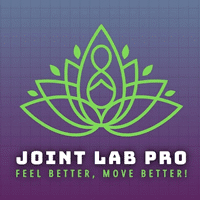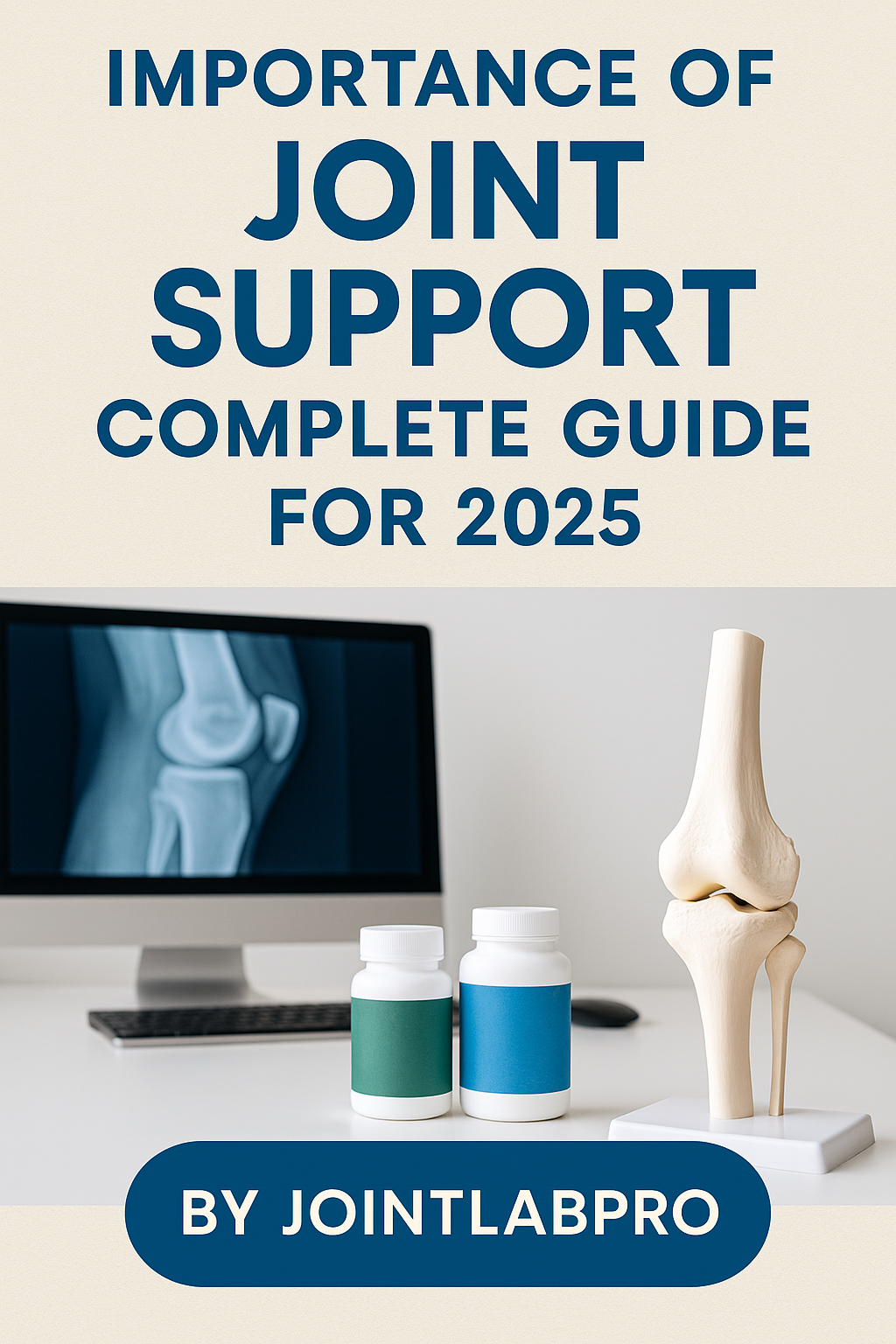JointLabPro Joint Health Guides
Importance of Joint Support: Complete Guide for 2025
Evidence-based overview for adults 30+, active people, and clinicians who support them. Updated November 2025.
This guide is informational only and not medical advice. If you have ongoing joint pain, arthritis, recent injury, or other diagnoses, talk with your doctor or physical therapist before changing your routine or starting new supplements.
Joint pain and stiffness impact a large share of adults worldwide, especially after age 40. Knees, hips, and shoulders take the most load from daily life, sports, and work. When joints become painful or unstable, it affects everything: walking, sleep, mood, and long-term independence.
This complete joint support guide for 2025 brings together what matters most: major causes of joint pain, how braces and supplements actually work, when gentle exercise helps, and how to combine all three in a realistic, sustainable plan.
Looking for specific products that fit into a joint support plan?
Explore our current Best Joint Health Picks (2025) – including braces, glucosamine formulas, and turmeric supplements reviewed by JointLabPro.
1. What Is Joint Support?
Joint support means anything that helps your joints move more comfortably and safely over time. For most people, that includes some mix of:
| Component | Role in Joint Support |
|---|---|
| Muscular Strength | Strong muscles around a joint (for example, quadriceps around the knee, rotator cuff around the shoulder) take pressure off cartilage and ligaments. |
| Proprioception & Balance | Your body’s sense of position and control. Better balance reduces falls, awkward landings, and sudden overloads on joints. |
| Biomechanical Alignment | How your joints line up when you walk, squat, lift, or stand. Good alignment spreads forces more evenly and helps prevent uneven wear. |
In practice, joint support is rarely just one thing. The best results usually come from combining strength, smart movement, and – when appropriate – external support like braces or orthotics.
Want a practical example? See our knee brace + exercise breakdown in the PowerLix & Bauerfeind review inside Best Picks 2025.
2. Main Causes of Joint Pain & Stiffness
Understanding why a joint hurts makes it easier to choose the right type of support. Common causes include:
- Osteoarthritis (wear-and-tear) – the most common, especially in knees, hips, and hands.
- Old injuries – previous sprains, tears, or fractures can leave joints vulnerable years later.
- Overuse and repetitive stress – repetitive kneeling, lifting, typing, or overhead work.
- Inflammatory conditions – such as rheumatoid arthritis or gout.
- Weak supporting muscles – for example, weak glutes often overload the knees.
Even without a formal diagnosis, patterns can be helpful. Stiffness in the morning that eases with movement may behave differently than sharp pain with certain motions, and both call for different strategies. A clinician can help clarify what’s driving your symptoms.
For a simple, movement-focused starting point, see our guide: 3 Natural Tips for Knee Pain Relief (2025).
3. Types of Joint Support: Equipment, Exercise & Habits
Most joint support plans sit on three pillars: external support, movement, and everyday habits.
3.1 External Support: Braces, Orthotics & Aids
- Compression sleeves – add light stability and warmth for knees, elbows, and wrists.
- Structured braces – offer more control for unstable joints or after injuries.
- Orthotics & shoe inserts – help align ankles, knees, and hips during walking.
- Walking aids – a cane or pole can temporarily unload a painful joint.
These can make a big difference in comfort and confidence, especially when starting a new exercise routine or during flares – but they work best when paired with strength and mobility work, not instead of it.
For brace options, check the knee support picks inside our Best Joint Health Picks (2025).
3.2 Exercise: Strong Muscles, Happier Joints
Low-impact exercise is one of the most reliable ways to support joints over time. Examples:
- Short walks spread through the day
- Stationary bike or elliptical
- Light resistance training 2–3x/week
- Targeted rehab moves for specific joints
Done consistently, these can improve comfort, stiffness, and confidence. If you’re unsure where to start, a physical therapist or sports medicine clinician can tailor a routine to your knees, hips, or shoulders.
Shoulder issues? See our step-by-step routine: 7 Simple Shoulder Exercises for Pain Relief in 2025.
3.3 Daily Habits & Lifestyle Factors
- Weight management – even small changes can reduce load on knees and hips.
- Sleep & recovery – joints repair best when your overall recovery is solid.
- Nutrition – a pattern rich in whole foods, omega-3s, and anti-inflammatory spices (like turmeric).
- Breaks from static positions – set a timer to move every 30–60 minutes.
4. How Supplements & Braces Can Work Together
Many people find the best comfort from combining external support (like a sleeve or brace), structured movement, and thoughtful supplementation.
| Supplement | Typical Role | Notes |
|---|---|---|
| Glucosamine + Chondroitin | Support cartilage structure and joint lubrication over time. | Often taken for at least 8–12 weeks before judging effect; not a fast painkiller. |
| MSM (Methylsulfonylmethane) | Sulfur donor involved in connective tissue; often used for comfort support. | Commonly combined with glucosamine in joint formulas. |
| Turmeric / Curcumin | Botanical anti-inflammatory support. | Absorption is typically improved when combined with black pepper extract (piperine). |
| Omega-3 (EPA/DHA) | Supports overall inflammatory balance. | Often recommended as part of heart + joint health patterns. |
Supplements are optional tools, not magic fixes. Some people notice a meaningful difference, others less so. They tend to work best when you are also addressing movement, weight, and daily habits.
Want real-world examples? See our in-depth breakdowns: Doctor’s Best Glucosamine review, Arazo Nutrition Joint Support review, and BioSchwartz Turmeric review.
5. Benefits, Risks & Common Pitfalls
5.1 Potential Benefits of a Thoughtful Joint Support Plan
- Less day-to-day stiffness and “rusty” feeling in the morning
- More confidence with stairs, inclines, or longer walks
- Better ability to keep up with work, hobbies, and family
- Lower chance of flare-ups from small triggers
5.2 Common Pitfalls to Avoid
- Relying only on braces – without building strength, joints stay vulnerable.
- Overdoing activity after one “good day” – big spikes in activity can trigger new flares.
- Random supplement stacking – combining many products without considering interactions or doses.
- Ignoring red flags – sudden swelling, redness, locking, or big changes in joint shape always need medical input.
If you use prescription medications, blood thinners, or have complex conditions (like autoimmune disease), talk with your clinician before adding joint supplements.
6. Key Takeaways & Next Steps for 2025
| Focus Area | Simple Action Step |
|---|---|
| Movement | Add 10 minutes of gentle joint-friendly movement daily (walk, bike, or targeted routine). |
| Support | Use a sleeve or brace when a joint feels unstable – especially for longer outings or heavier tasks. |
| Supplementation | If appropriate for you, trial one well-reviewed joint formula for 8–12 weeks, not five at once. |
| Monitoring | Keep a quick 0–10 comfort log for 4–6 weeks to spot patterns and improvements. |
Ready to put this into action?
Start by choosing one joint to focus on (for many, that’s the knee or shoulder), add a simple daily movement routine, and pair it with a single, well-chosen support product.
To make the product choice easier, we maintain a living list of trusted options in our Best Joint Health Picks (2025).

